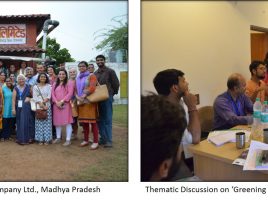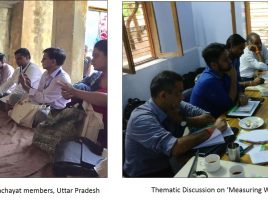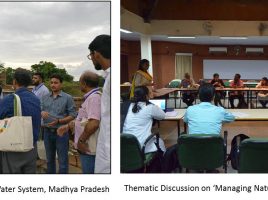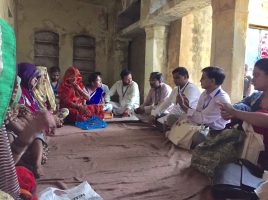Towards Financial Markets that are Accountable to Sustainability
It is not rare in this country that one hears of meetings, seminars, and consultations on various development themes. And when one stays in the capital city, Delhi, this is almost a daily affair, with designated centres – Indian Habitat Centre, Indian International Centre, Press Club of India – where evenings usually host lectures, documentary screenings and seminars.
The rare bit of what we are going to share through this blog is in the design of this event – TARAgram Yatra – and an insight on the theme of financial flows in the country, when discussed in such a design!
About TARAgram Yatra and the field visits
TARAgram Yatra, by its design, takes its yatris to a place where development practices have transformed or are transforming lives of people, generating sustainable livelihoods. This time, the Yatra went to Bundelkhand, an area where Development Alternatives has been working with the people to ensure better livelihoods, natural resource management and better living conditions in the region. Through a day on the field, exploring different development models and engaging with the communities, the yatris learnt about the intervention and the process that set up and run the model. The group of approximately 50 yatris was split into sub groups to visit three different models. This was followed by a de-brief session to share their experience with other yatris. Some of the common thoughts shared resonated around a great comeback for many practitioners and policy makers, to the field, to the communities they all aim to work for. Some of the yatris highlighted the need for an exit policy for Development Alternatives, as without it the communities may not be able to cope up in their absence. An interesting observation that we recall is the confidence amongst women in sharing their success of running a producer company and making profits from the same. These confident women, as a yatri mentioned, are capable of inspiring all stakeholders to strive towards more such stories.
Snippets from the session on financial flows in the country
These thematic sessions, as a part of TARAgram Yatra, were designed in the form of round tables. With 10-12 participants in each, the sessions gave enough scope for them to share and deliberate over opinions and experiences of their own and others on the table. The financial flows theme attracted a very diverse set of participants, including bankers from State Bank of India & YES BANK and civil society organisations working on sustainability in financial markets and accountability of financial institutions, like IUCN, Partners in Change – India and Centre for Financial Accountability. The round table also saw participation from entrepreneurs, consultants and members from local NGOs like Bundelkhand Seva Sansthan.
The diversity on the table enriched the discussion and led to identification of some very interesting cross roads for the country’s financial markets. Following are some of the glimpses:
Goods and Services Tax (GST) – A bane or a boon?
Some argue that GST has expanded the tax collection systems in the country, increasing the treasury of the country; it is seen as one of the most ambitious reforms that the country has taken with its tax systems. One of the extraordinary achievements claimed due to GST is the ease of cross boundary business, preventing taxes at multiple points. A discussant raised concerns on who suffers when big businesses gain because of ease of doing business in different geographies now. It was argued that small local businesses will lose their market share when it becomes cheaper for bigger businesses to enter those geographies.
An important point of action identified is to engage with the government in ensuring tax slabs of GST to promote green products and services. GST is a new tax regime, and the involvement of civil society at this point will help it evolve as a green tax. Another critical point mentioned is the need to define “green” in sectors and finance. This will bring clarity and uniformity in these markets which are currently defining it on their own, and therefore include controversial inclusions and exclusions in their definitions.
(Green) Public Procurement – The elephant in the room
With India spending 20-30% of its GDP on public procurement, it is of high critical value to incentivise sustainable production practices in the choice of procurement of products. While green public procurement has been considered a challenge mostly because of its definition and implementation concerns, there were examples of initiatives of green public procurement in pockets, with initiatives of certain state level departments, like including fly ash bricks in the schedule of rates in procurement policy of the state of Bihar. The group collectively felt that an ambitious policy like a green public procurement policy may not be possible at the national level, and such ambitions need to be shown by states taking the lead.
Responsible green banking – critical but slow
The round table had two very distinct opinions being shared. On one hand, the banks shared examples where innovative instruments like Green Bonds have been tested and are driving finance towards green businesses, while making banking sense in terms of investment benefits. At this point, defined holistic parameters beyond the current check list need to be developed, that truly capture social and environmental impacts of an investment.
On the other hand, an opinion was expressed on the very little accountability and information disclosure by banks in India, especially public sector banks, which is considered as a major roadblock for any accountability of the banks to its customers and citizens of the country.
An important thought shared by a yatri described how big financial institutes attract big investments, in order to make the investment portfolio of the bank manageable and workable. By this very nature, big financial institutions tend to exclude smaller businesses and MSMEs from their potential clients. Following the same argument, it is crucial to expand, diversify and empower smaller financial institutions, like micro finance institutions, for servicing the large rural markets.
Investing in MSMEs, especially in the rural areas
Many yatris felt that the banks have less faith in sanctioning loans to MSMEs, reasons mostly being little or no track record of the entrepreneurs on such nature of loans. Low awareness amongst the rural population – on various schemes that they can avail and possible use of the loan under each scheme – is also considered as a hindrance in availing loans by rural MSMEs.
A score card for all MSMEs that can be used while applying loans is seen to be a standard system that can ensure transparency and allow faith amongst the banks in disbursing such loans. A score card may include parameters of previous record, in addition to educational qualification, assets and other attributes.
Over all, for us, the most interesting part of the round table was the fact that there were voices from the ground, banks, government and civil society engaging with each other on issues that tie them all together – financial markets. The rigour and energy at the round table signal the involvement of the yatris, which we hope to see and capture in initiatives ahead, collectively to envision and move towards building accountability in our financial systems for sustainable development.
Anshul Bhamra (abhamra@devalt.org)
Pratibha Caleb (pcaleb@devalt.org)
Vaibhav Rathi (vrathi@devalt.org)
The views expressed in the article are those of the authors’ and not necessarily those of Development Alternatives.







Leave a Reply